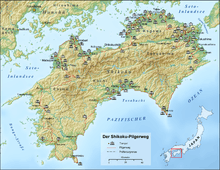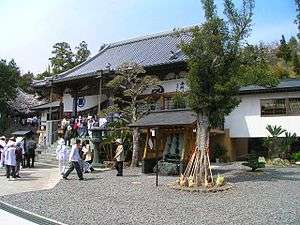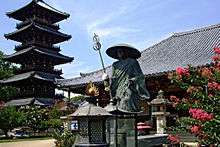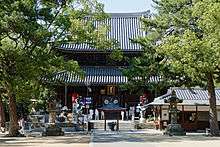Shikoku Pilgrimage
The Shikoku Pilgrimage (四国遍路, Shikoku Henro) or Shikoku Junrei (四国巡礼) is a multi-site pilgrimage of 88 temples associated with the Buddhist monk Kūkai (Kōbō Daishi) on the island of Shikoku, Japan. A popular and distinctive feature of the island's cultural landscape, and with a long history, large numbers of pilgrims, known as henro (遍路), still undertake the journey for a variety of ascetic, pious, and tourism-related purposes.[1] The pilgrimage is traditionally completed on foot, but modern pilgrims use cars, taxis, buses, bicycles, or motorcycles. The standard walking course is approximately 1,200 kilometres (750 mi) long and can take anywhere from 30 to 60 days to complete.


In addition to the 88 "official" temples of the pilgrimage, there are over 20 bangai — temples not considered part of the official 88. To complete the pilgrimage, it is not necessary to visit the temples in order; in some cases it is even considered lucky to travel in reverse order. Henro (遍路) is the Japanese word for pilgrim,[2] and the inhabitants of Shikoku call the pilgrims o-henro-san (お遍路さん), the o (お) being an honorific and the san (さん) a title similar to "Mr." or "Mrs.". They are often recognizable by their white clothing, sedge hats, and kongō-zue or walking sticks. Alms or osettai are frequently given. Many pilgrims begin and complete the journey by visiting Mount Kōya in Wakayama Prefecture, which was settled by Kūkai and remains the headquarters of Shingon Buddhism. The 21 kilometres (13 mi) walking trail up to Koya-san still exists, but most pilgrims use the train.
History
Background
Pilgrimages have played an important part in Japanese religious practice since at least the Heian period. Typically centred upon holy mountains, particular divinities, or charismatic individuals, they are usually to Buddhist sites although those to the shrines of Kumano and Ise are notable exceptions.[1][3]
Kōbō Daishi
Kūkai, born at Zentsū-ji (Temple 75) in 774, studied in China, and upon his return was influential in the promotion of esoteric Buddhism. He established the Shingon retreat of Kōya-san, was an active writer, undertook a programme of public works, and during visits to the island of his birth is popularly said to have established or visited many of its temples and to have carved many of their images. He is posthumously known as Kōbō Daishi.[4][5]
Development
The legends and cult of Kōbō Daishi, such as the episode of Emon Saburō, were maintained and developed by the monks of Kōya-san who travelled to expound Shingon and were active, along with other hijiri, in Shikoku.[6] In the Edo period, the policy of tochi kinbaku (土地緊縛) restricted and regulated the movement of ordinary people. Pilgrims were required to obtain travel permits, follow the main paths, and pass through localities within a certain time limit, with the book of temple stamps or nōkyō-chō helping to provide proof of passage.[7]
Practice
Stages
Shikoku literally means "four provinces", those of Awa, Tosa, Iyo, and Sanuki, reorganised during the Meiji period into the prefectures of Tokushima, Kōchi, Ehime, and Kagawa. The pilgrim's journey through these four provinces is likened to a symbolic path to enlightenment, with temples 1–23 representing the idea of awakening (発心, hosshin), 24–39 austerity and discipline (修行, shugyō), 40–65 attaining enlightenment (菩提, bodai), and 66–88 entering nirvana (涅槃, nehan).[8]
Equipment
The pilgrim's traditional costume comprises a white shirt (白衣, oizuru), conical Asian hat (すげ笠, suge-kasa), and staff (金剛杖, kongō-zue). This may be supplemented by a ceremonial stole (輪袈裟, wagesa). The henro also carries a bag (頭陀袋, zuda-bukuro) containing name slips (納札, osame-fuda), prayer beads (数珠, juzu) (also known as nenju (念珠)), a booklet (納経帳, nōkyō-chō) to collect stamps/seals (朱印, shuin), incense sticks (線香, senkō), and coins used as offerings (お賽銭, o-saisen). The more religiously-minded henro may also carry a book of sutras (経本, kyōbon) and go-eika (ご詠歌) set with a bell.[9]
Rites
Upon arrival at each temple the henro washes before proceeding to the Hondō. After offering coins, incense, and the osame-fuda, the Heart Sutra (般若心経, Hannya Shingyō) is chanted along with repetition of the Mantra of the main image (本尊, honzon) and the Mantra of Light (光明真言, Kōmyō Shingon). After kigan and ekō prayers, the henro proceeds to the shrine of Kobo Daishi (大師堂, Daishidō). Coins and a fuda are similarly offered, and again the Heart Sutra is chanted, along with repetition of the Gohōgō Mantra, namu-Daishi-henjō-kongō.[9]
Imitative versions
Attesting to the popularity of the Shikoku pilgrimage, from the eighteenth century a number of smaller imitative versions have been established.[3] These include a 150 kilometres (93 mi) circuit on Shōdo Island northeast of Takamatsu;[10] a 3 kilometres (1.9 mi) course on the grounds of Ninna-ji in Kyoto;[11] a route on the Chita Peninsula near Nagoya;[12] and circuits in Edo and Chiba Prefecture.[3] Outside Japan, another version is on the Hawai'ian island of Kaua'i.[13]
Temples
Collectively, the 88 temples are known as Shikoku Hachijūhakkasho (四国八十八箇所) or simply the Hachijūhakkasho (八十八箇所).
| No. | Temple | Honzon (main image) | Location | Coordinates | Image |
|---|---|---|---|---|---|
| 1 | Ryōzen-ji (霊山寺) | Shaka Nyorai | Naruto, Tokushima | 34.159803°N 134.502592°E | |
| 2 | Gokuraku-ji (極楽寺) | Amida Nyorai | Naruto, Tokushima | 34.155556°N 134.490278°E | |
| 3 | Konsen-ji (金泉寺) | Shaka Nyorai | Itano, Tokushima | 34.147436°N 134.468544°E | |
| 4 | Dainichi-ji (大日寺) | Dainichi Nyorai | Itano, Tokushima | 34.151306°N 134.430889°E |  |
| 5 | Jizō-ji (地蔵寺) | Enmei Jizō Bosatsu | Itano, Tokushima | 34.137222°N 134.431944°E | |
| 6 | Anraku-ji (安楽寺) | Yakushi Nyorai | Kamiita, Tokushima | 34.118056°N 134.388389°E | |
| 7 | Jūraku-ji (十楽寺) | Amida Nyorai | Awa, Tokushima | 34.12075°N 134.377925°E |  |
| 8 | Kumadani-ji (熊谷寺) | Senju Kannon | Awa, Tokushima | 34.122778°N 134.34°E |  |
| 9 | Hōrin-ji (法輪寺) | Shaka Nyorai | Awa, Tokushima | 34.104378°N 134.333814°E | |
| 10 | Kirihata-ji (切幡寺) | Senju Kannon | Awa, Tokushima | 34.10775°N 134.304278°E | |
| 11 | Fujii-dera (藤井寺) | Yakushi Nyorai | Yoshinogawa, Tokushima | 34.051667°N 134.3485°E | |
| 12 | Shōsan-ji (焼山寺) | Kokūzō Bosatsu | Kamiyama, Tokushima | 33.985028°N 134.31025°E | |
| 13 | Dainichi-ji (大日寺) | Jūichimen Kannon | Tokushima, Tokushima | 34.038117°N 134.462683°E | |
| 14 | Jōraku-ji (常楽寺) | Miroku Bosatsu | Tokushima, Tokushima | 34.050333°N 134.475639°E | |
| 15 | Awa Kokubun-ji (阿波国分寺) | Yakushi Nyorai | Tokushima, Tokushima | 34.055611°N 134.473611°E | |
| 16 | Kannon-ji (観音寺) | Senju Kannon | Tokushima, Tokushima | 34.068472°N 134.474344°E | |
| 17 | Ido-ji (井戸寺) | Yakushi Nyorai | Tokushima, Tokushima | 34.085167°N 134.485444°E |  |
| 18 | Onzan-ji (恩山寺) | Yakushi Nyorai | Komatsushima, Tokushima | 33.986°N 134.57825°E | |
| 19 | Tatsue-ji (立江寺) | Jizō Bosatsu | Komatsushima, Tokushima | 33.967861°N 134.605806°E | |
| 20 | Kakurin-ji (鶴林寺) | Jizō Bosatsu | Katsuura, Tokushima | 33.913861°N 134.505611°E | |
| 21 | Tairyūji (太龍寺) | Kokūzō Bosatsu | Anan, Tokushima | 33.882528°N 134.521889°E | |
| 22 | Byōdō-ji (Tokushima) (平等寺) | Yakushi Nyorai | Anan, Tokushima | 33.851833°N 134.582778°E | |
| 23 | Yakuō-ji (薬王寺) | Yakushi Nyorai | Minami, Tokushima | 33.732306°N 134.527583°E | |
| 24 | Hotsumisaki-ji (最御崎寺) | Kokūzō Bosatsu | Muroto, Kōchi | 33.249008°N 134.175739°E | |
| 25 | Shinshō-ji (津照寺) | Jizō Bosatsu | Muroto, Kōchi | 33.287806°N 134.14825°E | |
| 26 | Kongōchō-ji (金剛頂寺) | Yakushi Nyorai | Muroto, Kōchi | 33.307222°N 134.122861°E | |
| 27 | Kōnomine-ji (神峰寺) | Jūichimen Kannon | Yasuda, Kōchi | 33.467611°N 133.974778°E | |
| 28 | Dainichi-ji (大日寺) | Dainichi Nyorai | Kōnan, Kōchi | 33.577583°N 133.705389°E | |
| 29 | Tosa Kokubun-ji (土佐国分寺) | Senju Kannon | Nankoku, Kōchi | 33.598694°N 133.640417°E | |
| 30 | Zenrakuji (善楽寺) | Amida Nyorai | Kōchi, Kōchi | 33.591917°N 133.577556°E |  |
| 31 | Chikurin-ji (竹林寺) | Monju Bosatsu | Kōchi, Kōchi | 33.546611°N 133.577472°E |  |
| 32 | Zenjibu-ji (禅師峰寺) | Jūichimen Kannon | Nankoku, Kōchi | 33.526694°N 133.611389°E | |
| 33 | Sekkei-ji (雪蹊寺) | Yakushi Nyorai | Kōchi, Kōchi | 33.500833°N 133.543083°E | |
| 34 | Tanema-ji (種間寺) | Yakushi Nyorai | Haruno, Kōchi | 33.491722°N 133.487583°E | |
| 35 | Kiyotaki-ji (清滝寺) | Yakushi Nyorai | Tosa, Kōchi | 33.5125°N 133.4095°E | |
| 36 | Shōryū-ji (青竜寺) | Fudō Myōō | Tosa, Kōchi | 33.426°N 133.450806°E | |
| 37 | Iwamoto-ji (岩本寺) | Five Buddhas | Shimanto, Kōchi | 33.207972°N 133.134611°E | |
| 38 | Kongōfuku-ji (金剛福寺) | Senju Kannon | Tosashimizu, Kōchi | 32.726028°N 133.018556°E | |
| 39 | Enkōji (延光寺) | Yakushi Nyorai | Sukumo, Kōchi | 32.961306°N 132.774056°E | |
| 40 | Kanjizai-ji (観自在寺) | Yakushi Nyorai | Ainan, Ehime | 32.964667°N 132.564056°E | |
| 41 | Ryūkōji (竜光寺) | Jūichimen Kannon | Uwajima, Ehime | 33.295194°N 132.5985°E | |
| 42 | Butsumoku-ji (佛木寺) | Dainichi Nyorai | Uwajima, Ehime | 33.310583°N 132.581472°E | |
| 43 | Meiseki-ji (明石寺) | Senju Kannon | Seiyo, Ehime | 33.369222°N 132.518972°E | |
| 44 | Daihō-ji (大宝寺) | Jūichimen Kannon | Kumakōgen, Ehime | 33.660889°N 132.912083°E | |
| 45 | Iwaya-ji (岩屋寺) | Fudō Myōō | Kumakōgen, Ehime | 33.658667°N 132.980722°E |  |
| 46 | Jōruri-ji (浄瑠璃寺) | Yakushi Nyorai | Matsuyama, Ehime | 33.753556°N 132.819111°E | |
| 47 | Yasaka-ji (八坂寺) | Amida Nyorai | Matsuyama, Ehime | 33.757944°N 132.812861°E | |
| 48 | Sairin-ji (西林寺) | Jūichimen Kannon | Matsuyama, Ehime | 33.793722°N 132.813944°E | |
| 49 | Jōdo-ji (浄土寺) | Shaka Nyorai | Matsuyama, Ehime | 33.816667°N 132.808528°E | |
| 50 | Hanta-ji (繁多寺) | Yakushi Nyorai | Matsuyama, Ehime | 33.828139°N 132.804556°E |  |
| 51 | Ishite-ji (石手寺) | Yakushi Nyorai | Matsuyama, Ehime | 33.847861°N 132.796472°E | |
| 52 | Taisan-ji (太山寺) | Jūichimen Kannon | Matsuyama, Ehime | 33.885083°N 132.714972°E | |
| 53 | Enmyō-ji (圓明寺) | Amida Nyorai | Matsuyama, Ehime | 33.89175°N 132.739667°E | |
| 54 | Enmei-ji (延命寺) | Fudō Myōō | Imabari, Ehime | 34.066833°N 132.964°E | |
| 55 | Nankōbō (南光坊) | Daitsū-chishō Butsu | Imabari, Ehime | 34.06875°N 132.99575°E | |
| 56 | Taisan-ji (泰山寺) | Jizō Bosatsu | Imabari, Ehime | 34.050111°N 132.974583°E | |
| 57 | Eifuku-ji (栄福寺) | Amida Nyorai | Imabari, Ehime | 34.029472°N 132.978472°E | |
| 58 | Senyū-ji (仙遊寺) | Senjū Kannon | Imabari, Ehime | 34.013194°N 132.977361°E | |
| 59 | Iyo Kokubun-ji (伊予国分寺) | Yakushi Nyorai | Imabari, Ehime | 34.026167°N 133.025444°E | |
| 60 | Yokomine-ji (横峰寺) | Dainichi Nyorai | Saijō, Ehime | 33.837861°N 133.111139°E |  |
| 61 | Kōon-ji (香園寺) | Dainichi Nyorai | Saijō, Ehime | 33.893528°N 133.103306°E | |
| 62 | Hōju-ji (宝寿寺) | Jūichimen Kannon | Saijō, Ehime | 33.897333°N 133.114944°E | |
| 63 | Kichijō-ji (吉祥寺) | Bishamonten | Saijō, Ehime | 33.896056°N 133.129167°E | |
| 64 | Maegami-ji (前神寺) | Amida Nyorai | Saijō, Ehime | 33.890222°N 133.160667°E | |
| 65 | Sankaku-ji (三角寺) | Jūichimen Kannon | Shikokuchūō, Ehime | 33.967639°N 133.5865°E | |
| 66 | Unpen-ji (雲辺寺) | Senju Kannon | Miyoshi, Tokushima | 34.035222°N 133.723722°E | |
| 67 | Daikō-ji (大興寺) | Yakushi Nyorai | Mitoyo, Kagawa | 34.102194°N 133.719167°E | |
| 68 | Jinne-in (神恵院) | Amida Nyorai | Kan'onji, Kagawa | 34.133986°N 133.647333°E | |
| 69 | Kannon-ji (観音寺) | Shō Kannon | Kan'onji, Kagawa | 34.1345°N 133.647528°E | |
| 70 | Motoyama-ji (本山寺) | Batō Kannon | Mitoyo, Kagawa | 34.139667°N 133.694056°E |  |
| 71 | Iyadani-ji (弥谷寺) | Senju Kannon | Mitoyo, Kagawa | 34.229722°N 133.724261°E |  |
| 72 | Mandara-ji (曼荼羅寺) | Dainichi Nyorai | Zentsūji, Kagawa | 34.223306°N 133.750219°E | |
| 73 | Shusshakaji (出釈迦寺) | Shaka Nyorai | Zentsūji, Kagawa | 34.219389°N 133.750278°E | |
| 74 | Kōyama-ji (甲山寺) | Yakushi Nyorai | Zentsūji, Kagawa | 34.233194°N 133.765764°E | |
| 75 | Zentsū-ji (善通寺) | Yakushi Nyorai | Zentsūji, Kagawa | 34.225111°N 133.774139°E | _and_right_(Agy%C5%8D)_of_the_sanmon_gate_at_Zents%C5%AB-ji_in_Zents%C5%AB-ji_City_Kagawa_pref.jpg) |
| 76 | Konzō-ji (金倉寺) | Yakushi Nyorai | Zentsūji, Kagawa | 34.250097°N 133.781014°E | |
| 77 | Dōryū-ji (道隆寺) | Yakushi Nyorai | Tadotsu, Kagawa | 34.27675°N 133.762694°E | |
| 78 | Gōshō-ji (郷照寺) | Amida Nyorai | Utazu, Kagawa | 34.306694°N 133.824583°E | |
| 79 | Tennō-ji (天皇寺) | Jūichimen Kannon | Sakaide, Kagawa | 34.311472°N 133.882861°E | |
| 80 | Sanuki Kokubun-ji (讃岐国分寺) | Jūichimen & Senjū Kannon | Takamatsu, Kagawa | 34.303139°N 133.944167°E | |
| 81 | Shiromine-ji (白峯寺) | Senju Kannon | Sakaide, Kagawa | 34.333528°N 133.926764°E | |
| 82 | Negoro-ji (根香寺) | Senju Kannon | Takamatsu, Kagawa | 34.3445°N 133.960556°E | |
| 83 | Ichinomiya-ji (一宮寺) | Shō Kannon | Takamatsu, Kagawa | 34.286611°N 134.026583°E | |
| 84 | Yashima-ji (屋島寺) | Jūichimen & Senjū Kannon | Takamatsu, Kagawa | 34.357917°N 134.10125°E | |
| 85 | Yakuri-ji (八栗寺) | Shō Kannon | Takamatsu, Kagawa | 34.359889°N 134.139528°E | |
| 86 | Shido-ji (志度寺) | Jūichimen Kannon | Sanuki, Kagawa | 34.324306°N 134.179639°E | |
| 87 | Nagao-ji (長尾寺) | Shō Kannon | Sanuki, Kagawa | 34.266706°N 134.171719°E | |
| 88 | Ōkubo-ji (大窪寺) | Yakushi Nyorai | Sanuki, Kagawa | 34.191408°N 134.206733°E |
See also
- Shingon
- Kōyasan
- Japan 100 Kannon, pilgrimage composed of the Saigoku, Bandō and Chichibu pilgrimages.
- Saigoku 33 Kannon, pilgrimage in the Kansai region.
- Bandō 33 Kannon, pilgrimage in the Kantō region.
- Chichibu 34 Kannon, pilgrimage in Saitama Prefecture.
- Chūgoku 33 Kannon, pilgrimage in the Chūgoku region.
- Kannon
- Buddhism in Japan
- Tourism in Japan
- For an explanation of terms concerning Japanese Buddhism, Japanese Buddhist art, and Japanese Buddhist temple architecture, see the Glossary of Japanese Buddhism.
References
- Reader, Ian (1999). "34. Legends, Miracles and Faith in Kōbō Daishi and the Shikoku Pilgrimage". In Tanabe, George J. (ed.). Religions of Japan in Practice. Princeton University Press. pp. 360–9. ISBN 0-691-05789-3.
- Reader, Ian (2005). Making Pilgrimages: Meaning and Practice in Shikoku. University of Hawaii Press , p. 318. ISBN 978-0-8248-2907-0
- Kitagawa, Joseph M. (1987). On Understanding Japanese Religion. Princeton University Press. pp. 127–136. ISBN 0-691-10229-5.
- Hakeda, Yoshito S. (1972). Kūkai: Major Works. Columbia University Press. ISBN 0-231-05933-7.
- Miyazaki, Tateki (2004). Shikoku henro hitori aruki dōgyō-ninin. Matsuyama.
- Reader, Ian (2005). Making Pilgrimages: Meaning and Practice in Shikoku. University of Hawaii Press. pp. 42ff. ISBN 978-0-8248-2907-0.
- Kouamé, Nathalie (1997). "Shikoku's Local Authorities and Henro during the Golden Age of the Pilgrimage". Japanese Journal of Religious Studies. Nanzan University. 24 (3/4): 413–425. Archived from the original on 28 September 2014.
- Reader, Ian (2005). Making Pilgrimages: Meaning and Practice in Shikoku. University of Hawaii Press. pp. 52f. ISBN 978-0-8248-2907-0.
- Miyata, Taisen (2006). The 88 Temples of Shikoku Island, Japan. Koyasan Buddhist Temple, Los Angeles. pp. 15–18.
- "Shodoshima Guide Book". Organization for the Promotion of Tourism in Shikoku. Retrieved 24 April 2011.
- "Hachijūhakkasho". Ninna-ji. Retrieved 25 April 2011.
- "Chita Hachijūhakkasho". Chita 88. Retrieved 25 April 2011.
- "Lawai International Center". Retrieved 27 December 2014.
Further reading
- Dempster, Lisa (2009). Neon Pilgrim'. Footscray West, Vic.: Aduki Independent Press. ISBN 0-9803351-7-5.
- Lewis-Kraus, Gideon (2012). A Sense of Direction. New York: Riverhead Books. ISBN 978-1-59448-725-5.
- McLachlan, Craig (1997). Tales of a Summer Henro. Tokyo: Yohan Publications. ISBN 4-89684-257-X.
- Okamoto, Ryosuke (2019). Pilgrimages in the Secular Age: From El Camino to Anime. Tokyo: Japan Publishing Industry Foundation for Culture.
- Reader, Ian (2005). Making Pilgrimages: Meaning and Practice in Shikoku. Honolulu: University of Hawaii Press. ISBN 0-8248-2876-3.
- Sibley, Robert C. (2013). The Way of the 88 Temples: Journeys on the Shikoku Pilgrimage. Charlelottesville: University of Virginia Press. ISBN 978-0-8139-3472-3.
- Statler, Oliver (1983). Japanese Pilgrimage. New York: Morrow. ISBN 0-688-01890-4.
- Shennen, Wayne (2016). 88 and Forty: Walking Japan's Famous Shikoku Pilgrimage. Newblack Alchemy. ISBN 978-0-4733-7379-5.
External links
| Wikivoyage has a travel guide for 88 Temple Pilgrimage. |
| Wikimedia Commons has media related to Shikoku Pilgrimage. |
- (in English) Shikoku Pilgrimage A Guide For Non-Japanese
- Map of the 88 temples at Mum, I'm Here
- (in English) Documentary movie about the 88 Temple Pilgrimage
- (in English) Begin Japanology Season 5 EP16 : The Shikoku Pilgrimage 2012-05-03
- Guide to start the Shikoku 88 temples pilgrimage (french-english)
- (in English) Echoes of Incense - A Pilgrimage in Japan by Don Weiss
- (in English) A Shikoku Pilgrimage by Jasbir Sandhu
- (in Japanese) Root of Shikoku - Electronic signpost -
[[Category: Henro Michi, route 2018, Een Weg van Jasmijn, Ben Engelbertink
